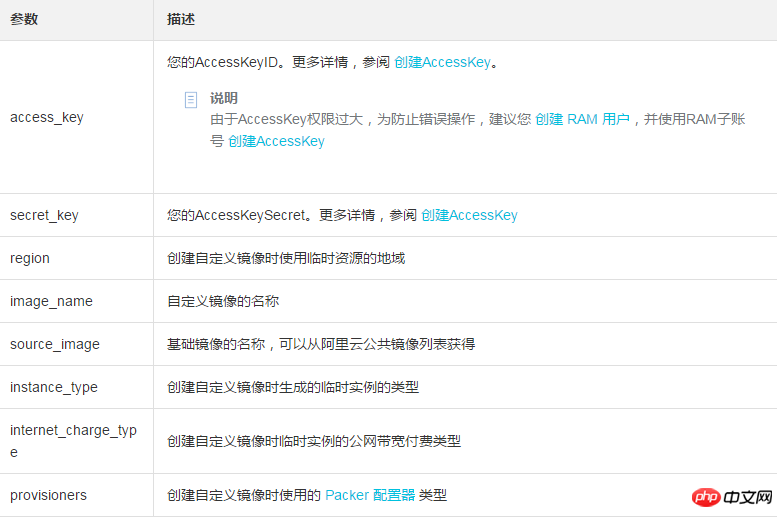本篇文章给大家带来的内容是关于如何使用开源工具 packer 便捷创建自定义镜像,有一定的参考价值,有需要的朋友可以参考一下,希望对你有所帮助。
使用Packer创建自定义镜像
开源工具 Packer 能够便捷创建自定义镜像。它能运行在大多数主流操作系统上。参阅本文安装并使用Packer,轻松创建自定义镜像。
说明
本文描述仅适用于运行Linux操作系统的服务器。
1. 安装Packer
您可以进入 Packer 官网下载页面,选择下载与您操作系统对应的版本,参阅以下步骤或者访问Packer 官方安装说明 安装 Packer。
连接并登录到Linux服务器。如果您的服务器为ECS Linux实例,可参阅文档 使用用户名密码验证连接 Linux 实例。
执行命令cd /usr/local/bin进入/usr/local/bin目录。
说明
/usr/local/bin 目录为环境变量目录,您可以将 Packer 安装到该目录下或其他已添加到环境变量的目录下。
执行命令wget https://releases.hashicorp.com/packer/1.1.1/packer_1.1.1_linux_amd64.zip获取Packer安装包。您可以访问 Packer 下载页面获取其他版本Packer安装包。
执行命令unzip packer_1.1.1_linux_amd64.zip解压文件。
执行命令packer -v验证Packer安装状态。若Linux服务器返回Packer版本号,表示您已正确安装Packer。若Linux服务器提示command not found表示Packer未正确安装。
2. 定义Packer模板
说明
使用Packer创建自定义镜像时,需要创建一个JSON格式的模板文件。在该模板文件中,您需要指定创建自定义镜像的 Alicloud Image Builder(生成器)和 Provisioners(配置器)。Packer具有多种配置器,可用于配置自定义镜像的内容生成方式,以下以常用的 Shell 配置器为例,定义Packer模板。
在Linux服务器中创建名为alicloud的json文件并粘贴以下内容。
{
"variables": {
"access_key": "{{env `ALICLOUD_ACCESS_KEY`}}",
"secret_key": "{{env `ALICLOUD_SECRET_KEY`}}"
},
"builders": [{
"type":"alicloud-ecs",
"access_key":"{{user `access_key`}}",
"secret_key":"{{user `secret_key`}}",
"region":"cn-beijing",
"image_name":"packer_basic",
"source_image":"centos_7_02_64_20G_alibase_20170818.vhd",
"ssh_username":"root",
"instance_type":"ecs.n1.tiny",
"internet_charge_type":"PayByTraffic",
"io_optimized":"true"
}],
"provisioners": [{
"type": "shell",
"inline": [
"sleep 30",
"yum install redis.x86_64 -y"
]
}]
}说明
您需要自定义以下参数值。

3. 使用Packer创建自定义镜像
指定Packer模板文件生成自定义镜像:
导入您的AccessKeyID:运行export ALICLOUD_ACCESS_KEY=您的 AccessKeyID 。
导入您的AccessKeySecret:运行export ALICLOUD_SECRET_KEY=您的 AccessKeySecret 。
执行命令packer build alicloud.json创建自定义镜像。
示例运行结果如下,以下示例将创建含Redis的自定义镜像:
alicloud-ecs output will be in this color. ==> alicloud-ecs: Prevalidating alicloud image name... alicloud-ecs: Found image ID: centos_7_02_64_20G_alibase_20170818.vhd ==> alicloud-ecs: Start creating temporary keypair: packer_59e44f40-c8d6-0ee3-7fd8-b1ba08ea94b8 ==> alicloud-ecs: Start creating alicloud vpc --------------------------- ==> alicloud-ecs: Provisioning with shell script: /var/folders/3q/w38xx_js6cl6k5mwkrqsnw7w0000gn/T/packer-shell257466182 alicloud-ecs: Loaded plugins: fastestmirror --------------------------- alicloud-ecs: Total 1.3 MB/s | 650 kB 00:00 alicloud-ecs: Running transaction check --------------------------- ==> alicloud-ecs: Deleting temporary keypair... Build 'alicloud-ecs' finished. ==> Builds finished. The artifacts of successful builds are: --> alicloud-ecs: Alicloud images were created: cn-beijing: m-2ze12578be1oa4ovs6r9
下一步
使用自定义镜像创建实例
以上就是如何使用开源工具 Packer 便捷创建自定义镜像的详细内容,更多请关注php中文网其它相关文章!

每个人都需要一台速度更快、更稳定的 PC。随着时间的推移,垃圾文件、旧注册表数据和不必要的后台进程会占用资源并降低性能。幸运的是,许多工具可以让 Windows 保持平稳运行。




Copyright 2014-2025 https://www.php.cn/ All Rights Reserved | php.cn | 湘ICP备2023035733号